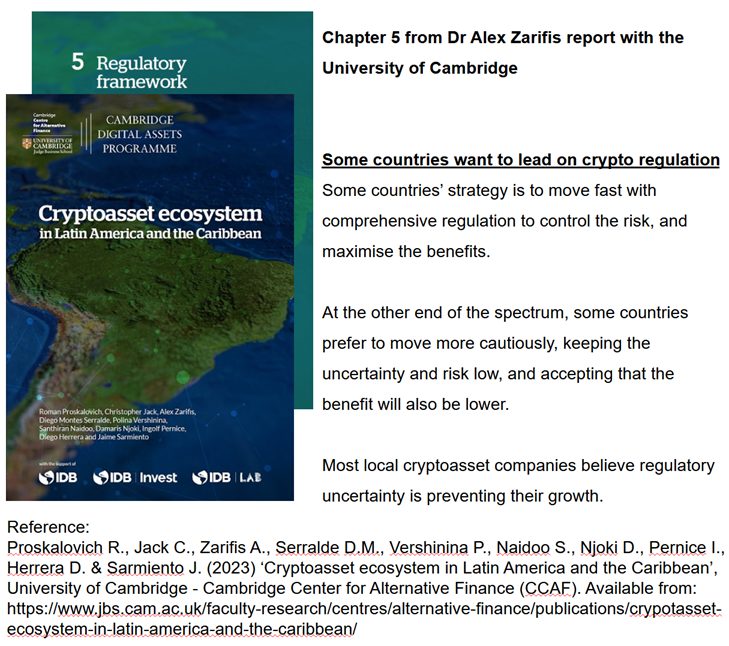This research is on the regulation of cryptoassets, such as Bitcoin, in Latin America. This is the fifth chapter of my report with the University of Cambridge, (Proskalovich et al. 2023). I have given a general overview of this report already, so I am just focusing on the chapter on regulation here.
Unlike a few years ago, most regulators in Latin America are now favourable towards cryptoassets. The prevailing belief is that cryptoassets, such as Bitcoin, are a valuable alternative to traditional finance, as they have different characteristics such as being decentralised. It is expected that cryptoassets can provide growth and a more inclusive financial landscape. They can provide easier cross-border payment, investments and loans. Cryptoassets can enable open-source collaboration reducing the barriers to entry for Fintech startups. Cryptoassets like NFTs can tokenise assets such as art, so that they can be offered to investors that may not be able to purchase the whole asset. In some scenarios, the way cryptoassets use blockchain can offer transparency in terms of what transactions have happened.
The main risks are believed to be misinformation, scams, and money laundering. Key challenges for regulators include (1) not enough staff with cryptoassets knowledge, (2) insufficient coordination between countries, and (3) lack of cooperation between the public and private sector.

Figure 1. Some countries in Latin America want to lead on crypto regulation, while others want to follow
There is an increase in regulators’ attention in the last few years with most countries either having or developing specialised rules. Despite most regulators agreeing that progress must be made, there is a large difference in the pace of progress. Some countries strategy is to lead with fast and comprehensive regulation to control the risk, and maximise the benefits. At the other end of the spectrum, some countries prefer to move more cautiously, keeping the uncertainty and risk low, and accepting that the benefit will also be lower. An example of a country leading is Mexico that is the first in Latin America to regulate cryptoasset trading platforms. Most local cryptoasset companies believe regulatory uncertainty is the biggest challenge preventing their growth.
Whether the regulators strategy is to lead, follow or something in-between, they need to follow the developments in the cryptoassets ecosystem both globally, and in Latin America, so that the right decisions are made at the right time, and friction between countries is limited.
If you want to learn more about regulation of cryptoassets like Bitcoin in Latin America, you can read the fifth chapter of the report.
Reference:
Proskalovich R., Jack C., Zarifis A., Serralde D.M., Vershinina P., Naidoo S., Njoki D., Pernice I., Herrera D. & Sarmiento J. (2023) ‘Cryptoasset ecosystem in Latin America and the Caribbean’, University of Cambridge – Cambridge Center for Alternative Finance (CCAF). Available from: https://www.jbs.cam.ac.uk/faculty-research/centres/alternative-finance/publications/crypotasset-ecosystem-in-latin-america-and-the-caribbean/